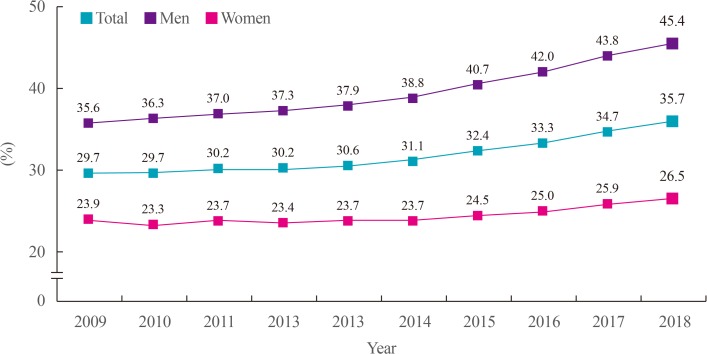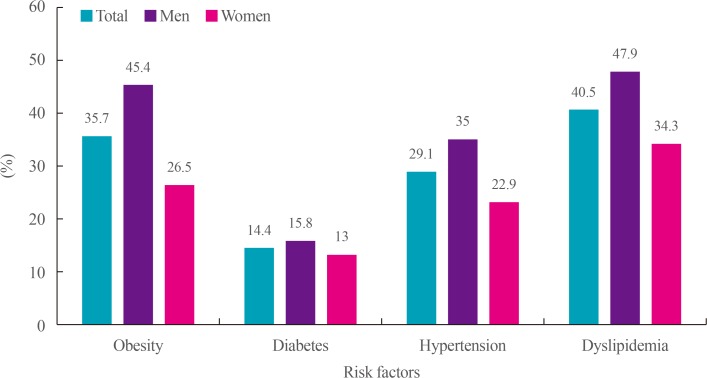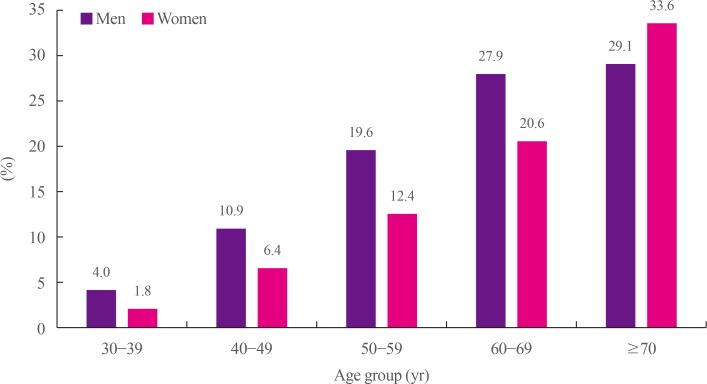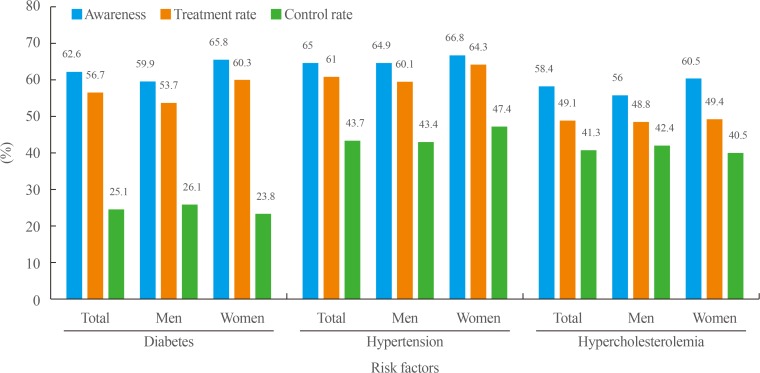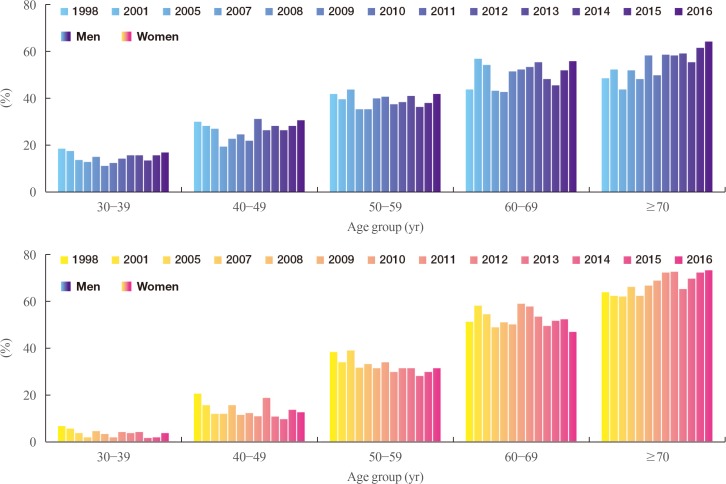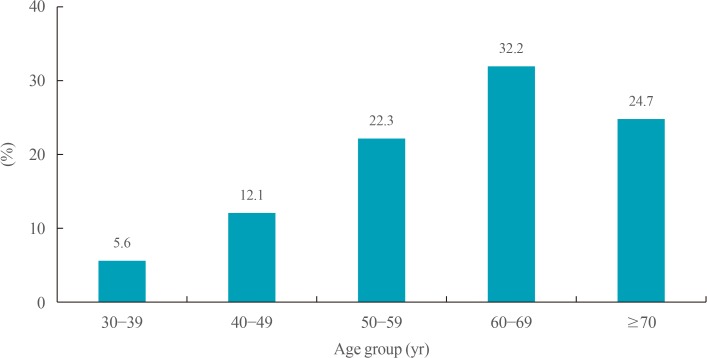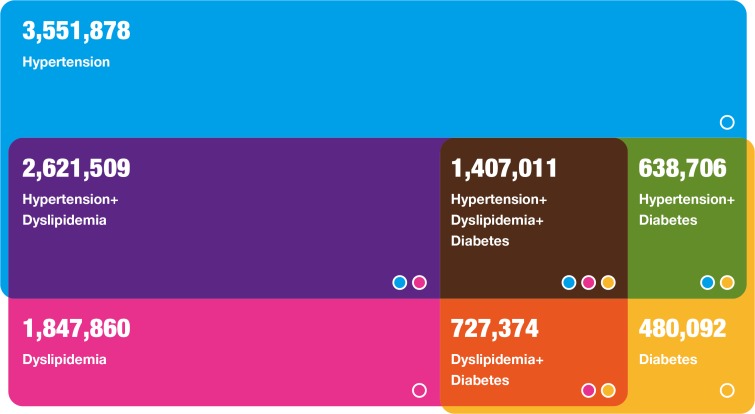Prevalence and Current Management of Cardiovascular Risk Factors in Korean Adults Based on Fact Sheets
- Affiliations
-
- 1Department of Endocrinology and Metabolism, Kangbuk Samsung Hospital, Sungkyunkwan University School of Medicine, Seoul, Korea. hongsiri@hanmail.net
- KMID: 2471723
- DOI: http://doi.org/10.3803/EnM.2020.35.1.85
Abstract
- Korea is currently an aged society and is on the cusp of becoming a superaged society in a few years. The health burden of cardiovascular diseases increases with age, and the increasing prevalence of cardiovascular risk factors, such as obesity, hypertension, diabetes mellitus, and dyslipidemia, may be linked to increased population-level cardiovascular risk. In 2018, the prevalence of obesity in Korea was 35.7% (men, 45.4%; women, 26.5%) according to the Obesity Fact Sheet 2019, based on National Health Insurance Corporation medical checkup data. In 2016, the prevalence of diabetes was 14.4% in Koreans older than 30 years according to the Diabetes Fact Sheet published by the Korean Diabetes Association, based on data from the Korean National Health and Nutrition Examination Survey. The prevalence of hypertension in the total population of Korea in 2018 was 28.3% according to the Korean Hypertension Fact Sheet produced by the Korean Society of Hypertension. Lastly, the prevalence of dyslipidemia in 2018 was 40.5% according to the Dyslipidemia Fact Sheet published by the Korean Society of Lipid and Atherosclerosis. In this article, I would like to review the prevalence and current management of cardiovascular risk factors in Korea according to the fact sheets released by various associations.
Keyword
MeSH Terms
Figure
Cited by 5 articles
-
A Century of Progress in Diabetes Care with Insulin: A History of Innovations and Foundation for the Future
Seung-Hwan Lee, Kun-Ho Yoon
Diabetes Metab J. 2021;45(5):629-640. doi: 10.4093/dmj.2021.0163.The Clinical Characteristics of Gestational Diabetes Mellitus in Korea: A National Health Information Database Study
Kyung-Soo Kim, Sangmo Hong, Kyungdo Han, Cheol-Young Park
Endocrinol Metab. 2021;36(3):628-636. doi: 10.3803/EnM.2020.948.Frequency of Exposure to Impaired Fasting Glucose and Risk of Mortality and Cardiovascular Outcomes
Seung-Hwan Lee, Kyungdo Han, Hyuk-Sang Kwon, Mee Kyoung Kim
Endocrinol Metab. 2021;36(5):1007-1015. doi: 10.3803/EnM.2021.1218.The Influence of Obesity and Metabolic Health on Vascular Health
Eun-Jung Rhee
Endocrinol Metab. 2022;37(1):1-8. doi: 10.3803/EnM.2022.101.Sex Differences in Coronary Artery Disease: Insights From the KoRean wOmen’S chest pain rEgistry (KoROSE)
Hack-Lyoung Kim, Myung-A Kim
Korean Circ J. 2023;53(10):655-676. doi: 10.4070/kcj.2023.0205.
Reference
-
1. Korean Statistical Information Service. Population in old ages [Internet]. Daejeon: Statistics Korea;2020. cited 2020 Feb 24. Available from: https://kosis.kr/eng/.2. Korean Society for the Study of Obesity. Obesity Fact Sheet [Internet]. Seoul: KOSSO;2020. cited 2020 Feb 24. Available from: http://www.kosso.or.kr/popup/obesity_fact_sheet.html.3. Korean Diabetes Association. Diabetes Fact Sheet in Korea [Internet]. Seoul: KDA;2020. cited 2020 Feb 24. Available from: https://www.diabetes.or.kr/pro/news/admin.php?mode=list&category=A.4. The Korean Society of Hypertension. 2018 Fact Sheet [Internet]. Seoul: KDA;2020. cited 2020 Feb 24. Available from: http://www.koreanhypertension.org/reference/guide?mode=read&idno=4166.5. The Korean Society of Lipid and Atherosclerosis. Dyslipidemia Fact Sheet 2018 [Internet]. Seoul: KDA;2020. cited 2020 Feb 24. Available from: https://www.lipid.or.kr/bbs/?code=fact_sheet.6. Lee YH, Han K, Ko SH, Ko KS, Lee KU. Taskforce Team of Diabetes Fact Sheet of the Korean Diabetes Association. Data analytic process of a nationwide population-based study using national health information database established by National Health Insurance Service. Diabetes Metab J. 2016; 40:79–82. PMID: 26912157.
Article7. Kweon S, Kim Y, Jang MJ, Kim Y, Kim K, Choi S, et al. Data resource profile: the Korea National Health and Nutrition Examination Survey (KNHANES). Int J Epidemiol. 2014; 43:69–77. PMID: 24585853.
Article8. Nam GE, Kim YH, Han K, Jung JH, Park YG, Lee KW, et al. Obesity fact sheet in Korea, 2018: data focusing on waist circumference and obesity-related comorbidities. J Obes Metab Syndr. 2019; 28:236–245. PMID: 31909366.9. WHO Expert Consultation. Appropriate body-mass index for Asian populations and its implications for policy and intervention strategies. Lancet. 2004; 363:157–163. PMID: 14726171.10. Seo MH, Lee WY, Kim SS, Kang JH, Kang JH, Kim KK, et al. 2018 Korean Society for the Study of Obesity guideline for the management of obesity in Korea. J Obes Metab Syndr. 2019; 28:40–45. PMID: 31089578.
Article11. Kim BY, Won JC, Lee JH, Kim HS, Park JH, Ha KH, et al. Diabetes fact sheets in Korea, 2018: an appraisal of current status. Diabetes Metab J. 2019; 43:487–494. PMID: 31339012.
Article12. Kim MK, Ko SH, Kim BY, Kang ES, Noh J, Kim SK, et al. 2019 Clinical practice guidelines for type 2 diabetes mellitus in Korea. Diabetes Metab J. 2019; 43:398–406. PMID: 31441247.
Article13. Zhang L, Qiao Q, Tuomilehto J, Hammar N, Ruotolo G, Stehouwer CD, et al. The impact of dyslipidaemia on cardiovascular mortality in individuals without a prior history of diabetes in the DECODE Study. Atherosclerosis. 2009; 206:298–302. PMID: 19303072.
Article14. Tominaga M, Eguchi H, Manaka H, Igarashi K, Kato T, Sekikawa A. Impaired glucose tolerance is a risk factor for cardiovascular disease, but not impaired fasting glucose: the Funagata Diabetes Study. Diabetes Care. 1999; 22:920–924. PMID: 10372242.
Article15. Korean Society Hypertension (KSH). Hypertension Epidemiology Research Working Group. Kim HC, Cho MC. Korea hypertension fact sheet 2018. Clin Hypertens. 2018; 24:13. PMID: 30288297.
Article16. Gaede P, Lund-Andersen H, Parving HH, Pedersen O. Effect of a multifactorial intervention on mortality in type 2 diabetes. N Engl J Med. 2008; 358:580–591. PMID: 18256393.
Article17. Kwon YH, Kim SK, Cho JH, Kwon H, Park SE, Oh HG, et al. The association between persistent hypertriglyceridemia and the risk of diabetes development: the Kangbuk Samsung Health Study. Endocrinol Metab (Seoul). 2018; 33:55–61. PMID: 29388400.
Article18. Wu L, Parhofer KG. Diabetic dyslipidemia. Metabolism. 2014; 63:1469–1479. PMID: 25242435.
Article
- Full Text Links
- Actions
-
Cited
- CITED
-
- Close
- Share
- Similar articles
-
- Prevalence and Current Status of Cardiometabolic Risk Factors in Korean Adults Based on Fact Sheets 2024
- Prevalence and management of hypertension in Korean adults
- Dyslipidemia Fact Sheets in Korea 2020: an Analysis of Nationwide Population-based Data
- A Two-step Clustering Approach for Measuring Socioeconomic Factors Associated with Cardiovascular Health among Older Adults in South Korea
- Association between Abdominal Obesity and Cardiovascular Risk Factors in Adults with Normal Body Mass Index: Based on the Sixth Korea National Health and Nutrition Examination Survey

